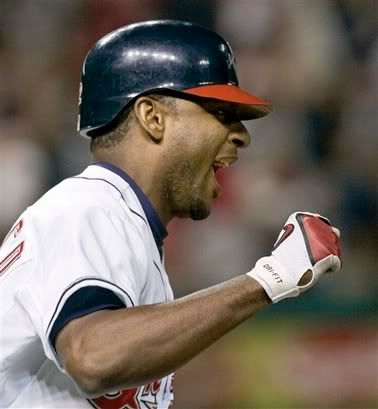 Indians Archive
Indians Archive  And In This Corner ...
And In This Corner ...

After The Frisco Kid burst onto the local sports scene last night (and Frank the Tank continues to impress), the call for a more productive LF & RF will intensify as people will see how these “kids” can do better than Michaels and Nixon and dream about how a Ken Griffey, Jr. or an Adam Dunn immediately makes the Indians the odds-on favorite to win the World Series because of the increased run production.
But how important is it to have a stud corner OF if the other positions are producing runs (the Indians remain 2nd in MLB in runs scored) and the starting rotation finally looks to be healthy and intact for an extended run?
How have past World Series winners been constructed in regards to their corner outfield positions?
Using Baseball Reference, here are the players that manned the two corner positions (or played the most games that particular year at that position) for World Series Champs since 2000:
Note: The first three numbers refer to Batting Average / On-Base % / Slugging %
2006 St. Louis
LF – So Taguchi (.266 / .335 / .351, 2 HR, 31 RBI)
RF – Juan Encarnacion (.278 / .317 / .443, 19 HR, 79 RBI)
2005 Chicago
LF – Scott Podsednik (.290 / .351 .349, 0 HR, 25 RBI)
RF – Jermaine Dye (.274 / .333 / .512, 31 HR, 86 RBI)
2004 Boston
LF – Manny Ramirez (.308 / .397 / .613, 43 HR, 130 RBI)
RF – Gabe Kapler (.272 / .311 / .390, 6 HR, 33 RBI)
2003 Florida
LF – Todd Hollandsworth (.254 / .317 / .421, 3 HR, 20 RBI)
RF – Juan Encarnacion (.270 / .313 / .446, 19 HR, 94 RBI)
2002 Anaheim
LF – Garrett Anderson (.306 / .332 / .539, 29 HR, 123 RBI)
RF – Tim Salmon (.286 / .380 / .503, 22 HR, 88 RBI)
So, while it’s obviously nice to have a Manny Ramirez in the lineup, having a huge corner bat doesn’t automatically translate into World Series pennants.
So Taguchi?
Gabe Kapler?
Todd Hollandsworth?
Consider the outfield production of this pair:
LF – (.317 / .401 / .690, 50 HR, 126 RBI)
RF – (.308 / .402 / .558, 31 HR, 107 RBI)
Now that’s some corner production!
Yes, it’s Albert and Manny, circa 1995, the combination of unrivaled talent that has led a generation of Indians’ fans to believe that it is imperative to have two HUGE bats in the corner OF positions.
Not to discount that unbelievable team that 75% of Clevelanders can still name top to bottom, but that team didn’t win the World Series did they?
Got beat by some team that hung their collective hat on their starting pitching, right?
While I certainly agree that better production from RF is necessary as the team is getting nothing from Trot Nixon and should give Frank the Tank and The Frisco Kid a good long look, where exactly does it say that you MUST have corner OF that are MVP candidates to win the World Series.
It may be blasphemy, but the build of the 2007 Indians most closely resembles the Yankees teams of the mid-1990’s. Both teams have exceptional catchers (Posada & The Stick), SS (Jeter & Peralta), CF (Bernie & Grady) and a 1B/DH (Tino & Pronk).
Between the Indians’ runs at the pennant, the Yanks pulled two rings in 1996 and 1998. Their starting corner OF production:
1998 New York
LF – Chad Curtis (.243 / .355 / .360, 10 HR, 56 RBI)
RF – Paul O’Neill (.317 / .372 / .510, 24 HR, 116 RBI)
1996 New York
LF – Gerald Williams (.270 / .319 / .433, 5 HR, 30 RBI)
RF – Paul O’Neill (.302 / .411 / .474, 19 HR, 91 RBI)
Paul O’Neill’s a nice little player, but Chad Curtis? Gerald Williams?
The rest of their 1998 lineup (the one that won 114 games) included Chuck Knoblauch , Scott Brosius, and Daryl Strawberry. The 1996 team had Mariano Duncan, Wade Boggs, and Ruben Sierra!
The point is that the production from one particular position gets overblown by expectations that your “power positions” should be generating RBI’s by the bushel every day. The fact is that run-producing corner position players don’t just grow on trees is lost on people who long for the days of Manny roaming RF (by the way, Dellichaels – or Dellucci and Michaels – have 45 RBI, Manny has 43) and Albert prowling around LF.
I’m all for giving the youngsters some AB’s in lieu of Nixon in the lineup, but let’s hold off the “they’re one or two bats away” talk and turn to the real issues that litter the 6th and 7th inning relief corps.
- NBA Announces 2013-2014 Schedule
- Browns Ink Sharknado
- Sharknado A No-Show For Rookie Camp
- Trent Richardson Out Until Training Camp
- Browns Sign Brandon Jackson
- Carrasco Suspended Eight Games
- Browns Add to Wide Receiver Depth with David Nelson
- Browns Need to Learn from Past Draft Mistakes
- Browns Release Chris Gocong and Usama Young
- Browns Missing on Grimes Disappointing, But Not The End
The TCF Forums
- Official- Browns Coach Search/Rumors
Larvell Blanks (Tuesday, January 21 2014 11:53 AM) - The 2014 Offseason Thread
skatingtripods (Tuesday, January 21 2014 11:52 AM) - Chris Grant's first 3 drafts
Kingpin74 (Tuesday, January 21 2014 10:13 AM) - 2015 Recruiting
furls (Tuesday, January 21 2014 6:57 AM) - Mike Brown
YahooFanChicago (Monday, January 20 2014 11:15 PM) - Movies coming out
HoodooMan (Monday, January 20 2014 9:34 PM) - 2014 Hoops Hockey Hijinx
jpd1224 (Monday, January 20 2014 4:44 PM) - 2014 Recruiting
jclvd_23 (Monday, January 20 2014 2:26 PM) - Wish List - #4 Pick
Hikohadon (Monday, January 20 2014 1:26 PM) - #1 overall pick Anthony Bennett
TouchEmAllTime (Sunday, January 19 2014 1:28 PM)


